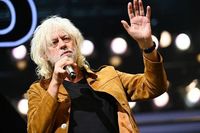On July 13, 2025, the world paused to honor a monumental moment in music and humanitarian history: the 40th anniversary of Live Aid. The groundbreaking 1985 concert, masterminded by Bob Geldof and Midge Ure, remains etched in collective memory as a pioneering global event designed to combat famine in Ethiopia. This year, Geldof and Ure attended a special performance of Just For One Day - The Live Aid Musical in London's West End, a production that vividly chronicles the electrifying moments leading up to the historic concerts.
Live Aid was unlike anything the world had seen before. It was a simultaneous spectacle held across two continents, with concerts at Wembley Stadium in London and JFK Stadium in Philadelphia. This dual-venue setup was a television first, seamlessly switching audiences between the two locations. The show was a star-studded affair, featuring legendary performers such as Queen, Elton John, David Bowie, George Michael, Tina Turner, Madonna, The Who, Status Quo, Sting, Phil Collins, and Paul McCartney. The event captivated an estimated 1.5 billion viewers across 150 countries, harnessing the power of music to raise awareness and funds for a desperate cause.
Bob Geldof, the driving force behind Live Aid, has often been candid about the event's behind-the-scenes realities. In a recent interview with The New York Times, he corrected a popular misconception portrayed in the film Bohemian Rhapsody. While many believed that Queen's iconic set caused the phone lines to crash due to donation surges, Geldof set the record straight: "The movie isn't right. Queen were completely, utterly brilliant. But the telephone lines collapsed after David Bowie performed." This revelation sheds new light on the emotional peak of the concert, highlighting Bowie's profound impact on viewers worldwide.
David Bowie's performance was deeply intertwined with the humanitarian message of the event. He was visibly moved by raw footage from a Canadian news report showing the harsh realities of the Ethiopian famine — images so stark they were deemed too graphic for television broadcast. Bowie made the poignant decision to cut a song from his set to air the CBC report instead, following his stirring rendition of "Heroes." His quiet, heartfelt plea for help resonated with millions, transforming his role from entertainer to impassioned humanitarian spokesman.
Queen's contribution to Live Aid remains legendary, with their set often hailed as one of the greatest live performances in rock history. Peter Hince, Queen's roadie, reflected on the moment, telling PEOPLE magazine, "They just nailed it. I think it was the right time. The audience had to sit through bands who maybe weren't as exciting as Queen were." Their performance was a high-energy highlight that perfectly captured the spirit of the day.
Among the many unforgettable stories from Live Aid, one of the most iconic involves Phil Collins and the supersonic Concorde. After delivering a dynamic set in London alongside Sting, Collins embarked on a remarkable journey that epitomized the event's ambitious scale. He was whisked away by helicopter to board the Concorde, the legendary supersonic jet, and flew across the Atlantic to Philadelphia. Collins arrived just 30 minutes before taking the stage again, this time performing with Eric Clapton. The feat of performing on two continents in a single day captured the imagination of fans and symbolized the extraordinary logistics behind Live Aid.
Live Aid's origins trace back to a 1984 BBC news broadcast that profoundly affected Geldof. The harrowing images of famine-stricken Ethiopia spurred him and Scottish musician Midge Ure to action. They initially collaborated on the Band Aid single "Do They Know It's Christmas?" which became a massive success and laid the groundwork for the larger Live Aid concerts. Their vision was to leverage celebrity influence and the global reach of television to raise funds and awareness on an unprecedented scale.
Financially, Live Aid was a resounding success, raising approximately $140 million to aid Ethiopia's famine relief efforts. The funds were distributed to various humanitarian organizations, helping to alleviate the suffering brought on by one of the worst famines in recent history. The concert not only demonstrated the power of music and media to mobilize global audiences but also set a benchmark for future charity events.
Reflecting on the 40th anniversary, the Just For One Day - The Live Aid Musical serves as a poignant reminder of the concert's enduring legacy. Attendees, including Geldof and Ure, experienced a theatrical journey through the tense, exhilarating, and hopeful lead-up to the event. The musical captures not just the performances but the spirit of unity and urgency that defined Live Aid.
Looking back, Live Aid was more than just a concert; it was a cultural milestone that showcased how collective action and celebrity influence could address global crises. The involvement of artists across genres and generations, the innovative use of simultaneous broadcasts, and the sheer scale of the fundraising effort all contributed to its status as the "Greatest Show on Earth." As Bob Geldof and Midge Ure marked this milestone in London, the world was reminded of the power of music to inspire change, even decades later.

